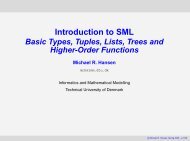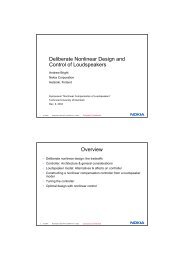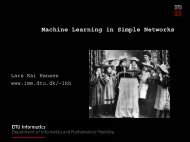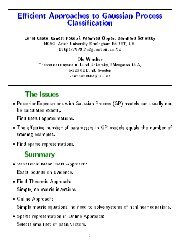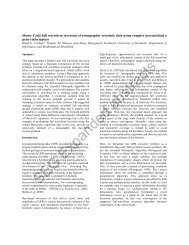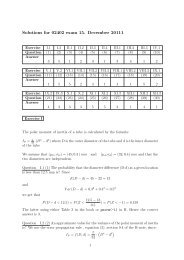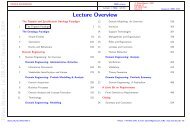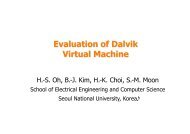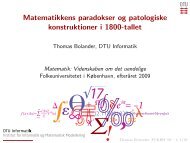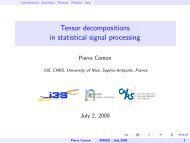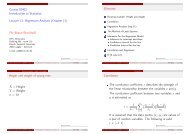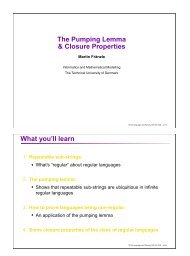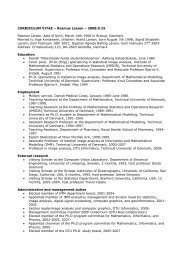NICE TO SEE YOU BACK - DTU Informatics
NICE TO SEE YOU BACK - DTU Informatics
NICE TO SEE YOU BACK - DTU Informatics
- No tags were found...
Create successful ePaper yourself
Turn your PDF publications into a flip-book with our unique Google optimized e-Paper software.
33<strong>NICE</strong> <strong>TO</strong> <strong>SEE</strong> <strong>YOU</strong> <strong>BACK</strong>A Precursor for Requirements Engineering 33 c○ Dines Bjørner 2012, <strong>DTU</strong> <strong>Informatics</strong>, Techn.Univ.of Denmark – July 20, 2012: 12:33
34Begin of Lecture 1: Last Session — Endurant EntitiesPartsFM 2012 Tutorial, Dines Bjørner, Paris, 28 August 2012c○ Dines Bjørner 2012, <strong>DTU</strong> <strong>Informatics</strong>, Techn.Univ.of Denmark – July 20, 2012: 12:33 34 Domain Science & Engineering
36 2. Domain Entities• When we observe a domain we observe instances of entities;• but when we describe those instances– (which we shall call values)– we describe, not the values,– but their type and properties.∗ Parts and materials have types and values;∗ actions, events and behaviours, all, have types and values,namely as expressed by their signatures; and∗ actions, events and behaviours have properties,namely as expressed by their function definitions.c○ Dines Bjørner 2012, <strong>DTU</strong> <strong>Informatics</strong>, Techn.Univ.of Denmark – July 20, 2012: 12:33 36 Domain Science & Engineering
2. Domain Entities37• Algebra: Taking a clue from mathematics, an algebra is considered– a set of parts and a set of materials and– a set of operations on entities. The operations yield parts ormaterials.• With that in mind we shall try view a domainas an algebra, of some kind, of– parts and– actions, events and behaviours.• We shall soon discuss the use of the terms– entities,– parts,– actions,– events and– behaviours.A Precursor for Requirements Engineering 37 c○ Dines Bjørner 2012, <strong>DTU</strong> <strong>Informatics</strong>, Techn.Univ.of Denmark – July 20, 2012: 12:33
382. Domain Entities• Phenomena: By a phenomenon we shall understand– something that can be observed by the human senses– or by equipment based on laws of physics and chemistry.• Those phenomena that can be observed by– the human eye or– touched, for example, by human hands– we call parts and materials.• Those phenomena that can be observed of parts and materials– can usually be measured– and we call them properties of these parts and those materials.c○ Dines Bjørner 2012, <strong>DTU</strong> <strong>Informatics</strong>, Techn.Univ.of Denmark – July 20, 2012: 12:33 38 Domain Science & Engineering
2. Domain Entities39• Ontology: There are two, related meanings to this term:– an ontology is the formal, explicit specification of a sharedconceptualisation [ontology:Gruber:1993],– and ontology∗ is the philosophical study of the natureof being, existence, or reality,∗ as well as the basic categories of being and their relations.• Thus– ontology deals with questions concerningwhat entities exist or can be said to exist,– and how such entities can be grouped, related within a hierarchy,– and subdivided according to similarities and differences.• In our study of domains we shall therefore often“border” on issues of philosophy.A Precursor for Requirements Engineering 39 c○ Dines Bjørner 2012, <strong>DTU</strong> <strong>Informatics</strong>, Techn.Univ.of Denmark – July 20, 2012: 12:33
402. Domain Entities• Domain Ontology:– A domain ontology (or a domain specific ontology) models∗ a specific domain.∗ with a domain description describing this model.• Ontological Engineering:– By ontological engineering we understand∗ (i) the study and knowledge of methods and methodologies forbuilding ontologies, and∗ (ii) the practice of these methods.– Ontological engineering thus has some relations to the TripTychapproach’s domain engineering,– but will first elaborate on that much later in this tutorial(Slide 380).c○ Dines Bjørner 2012, <strong>DTU</strong> <strong>Informatics</strong>, Techn.Univ.of Denmark – July 20, 2012: 12:33 40 Domain Science & Engineering
2. Domain Entities 2.1. Entities412.1. Entities• Ontologically we distinguish between two kinds of domain entities:– endurant entities and– perdurant entities.• We shall characterise these two terms– endurants on Slide 51 and– perdurants on Slide 145.• This distinction is supported by current literature on ontology[BarrySmith1993].• In this section of this lecture we shall briefly enter a discourse on– “things”,– entities,– objects,– etcetera.A Precursor for Requirements Engineering 41 c○ Dines Bjørner 2012, <strong>DTU</strong> <strong>Informatics</strong>, Techn.Univ.of Denmark – July 20, 2012: 12:33
422. Domain Entities 2.1. Entities2.1.1. Things, Entities, Objects2.1.1. Things, Entities, Objects• In colloquial language, that is, in the vernacular, everyday speech,– we may refer to that which we are talking about, describing,identifying, as the∗ ‘thing’,∗ ‘entity’,∗ ‘object’,∗ ‘individual’,∗ ‘unit’,∗ ‘term’,∗ ‘particular’,∗ ‘quantity’,.etcetera.• The problem is:– we need words– and we use words,– and, to avoid confusion, we should use one word, one term,– per concept.c○ Dines Bjørner 2012, <strong>DTU</strong> <strong>Informatics</strong>, Techn.Univ.of Denmark – July 20, 2012: 12:33 42 Domain Science & Engineering
2. Domain Entities 2.1. Entities2.1.1. Things, Entities, Objects43• So where– some may use the∗ term ‘thing’ or the∗ term ‘term’, or the∗ term ‘object’,∗ etcetera,interchangeably,– we shall use the term ‘entity’ consistently.A Precursor for Requirements Engineering 43 c○ Dines Bjørner 2012, <strong>DTU</strong> <strong>Informatics</strong>, Techn.Univ.of Denmark – July 20, 2012: 12:33
442. Domain Entities 2.1. Entities2.1.2. Spatial and Temporal, Manifest and Abstract2.1.2. Spatial and Temporal, Manifest and Abstract• Some philosophers “divide” entities (disjointly) into– spatial entities,corresponding to endurants, and– temporal entitiescorresponding to perdurants.• Some authors use the term object either as– manifest object (concrete object, tangible object) or as– ‘fiat’ object 11 or abstract object.Example: 4 Spatial Entities.• manifest entity: a geographical well delineated area;• abstract entity: the border of that area.11From Latin: an authoritative determinationc○ Dines Bjørner 2012, <strong>DTU</strong> <strong>Informatics</strong>, Techn.Univ.of Denmark – July 20, 2012: 12:33 44 Domain Science & Engineering
2. Domain Entities 2.1. Entities2.1.3. A Description Bias45• One of several “twists”2.1.3. A Description Bias– that make the TripTych form of domain engineering– distinct from that of ontological engineering– is that we use a model-oriented formal specification language 12– where usual ontology formalisation languages are variants ofLisp’s [Lisp1] S-expressions.–KIF: Knowledge Interchange Format,http://www.ksl.stanford.edu/knowledge-sharing/kif/is a leading example.12RSL [RSL], the Raise ([RaiseMethod]) Specification Language. Our remarks in thissection apply equally well had we instead chosen either of the Alloy [alloy], B,Event B [JRAbrial:TheBBooks], VDM SL [e:db:Bj78bwo,e:db:Bj82b,jf-pgl-97], or Z[m:z:jd+jcppw96] formal specification languages.A Precursor for Requirements Engineering 45 c○ Dines Bjørner 2012, <strong>DTU</strong> <strong>Informatics</strong>, Techn.Univ.of Denmark – July 20, 2012: 12:33
462. Domain Entities 2.1. Entities2.1.3. A Description Bias• The bias is now this:– The model-oriented languages mentioned in this section all sharethe following:∗ (a) a type concept and facilities for defining types, that is:endurants (parts), and∗ (b) a function concept and facilities for defining functions(notably including predicates), that is: perdurants (actionsand events).∗ (c) RSL further has constructs for defining processes, which weshall use to model behaviours.c○ Dines Bjørner 2012, <strong>DTU</strong> <strong>Informatics</strong>, Techn.Univ.of Denmark – July 20, 2012: 12:33 46 Domain Science & Engineering
2. Domain Entities 2.1. Entities2.1.4. An ‘Upper Ontology’472.1.4. An ‘Upper Ontology’• By an upper ontology we shall understand– a relatively small, ground set of ontology expressions– which form a basis for a usually very much larger set of ontologyexpressions.A Precursor for Requirements Engineering 47 c○ Dines Bjørner 2012, <strong>DTU</strong> <strong>Informatics</strong>, Techn.Univ.of Denmark – July 20, 2012: 12:33
482. Domain Entities 2.1. Entities2.1.4. An ‘Upper Ontology’• The need for introducing the notion of an upper ontology arose, inthe late 1980s to early 1990s as follows:– usually an ontology was (is) expressed in some very basiclanguage, viz., Lisp-like S-expressions 13 .– This was necessitated by the desire to be able to share ontologiesbetween many computing applications worldwide.– Then it was found that several ontologies shared initial bases interms of which the rest of their ontologies were formulated.– These shared bases were then referred to as upper ontologies —and a need to “standardise” these arose[ontology:guarino97a,StaabStuder2004].13Ontology languages: KIF http://www.ksl.stanford.edu/knowledge-sharing/kif/-#manual, OWL [Ontology Web Language] [OWL:2009], ISO Common Logic[ISO:CL:2007]c○ Dines Bjørner 2012, <strong>DTU</strong> <strong>Informatics</strong>, Techn.Univ.of Denmark – July 20, 2012: 12:33 48 Domain Science & Engineering
2. Domain Entities 2.1. Entities2.1.4. An ‘Upper Ontology’49• We therefore consider the following model-oriented specificationlanguage constructs as forming an upper ontology:– types, ground types, type expressions and type definitions;– functions, function signatures and function definitions;– processes, process signatures and process definitions,as constituting an upper level ontology for TripTych domaindescriptions.• That is, every domain description is structured with respect to:– parts and materials using types,– actions using functions,– events using predicates, and– behaviours using processes.• Participants in this tutorial are given a one-sheet upper ontologyfor the domain of domain science & engineering.A Precursor for Requirements Engineering 49 c○ Dines Bjørner 2012, <strong>DTU</strong> <strong>Informatics</strong>, Techn.Univ.of Denmark – July 20, 2012: 12:33
502. Domain Entities 2.2. Endurants2.2. Endurants• There is sort of a dichotomy buried in our treating endurantsbefore perdurants. The dichotomy is this:– one could claim that the perdurants,i.e., the actions, events and behavioursis “what it, the domain, is all about”;• To describe these, however, we need refer to endurants !c○ Dines Bjørner 2012, <strong>DTU</strong> <strong>Informatics</strong>, Techn.Univ.of Denmark – July 20, 2012: 12:33 50 Domain Science & Engineering
2. Domain Entities 2.2. Endurants2.2.1. General512.2.1. General• By an endurant (also known as a continuant or a substance) weshall understand an entity– that can be observed, i.e., perceived or conceived,– as a complete concept,– at no matter which given snapshot of time.• Were we to freeze time– we would still be able to observe the entire endurant.2.2.2. Discrete and Continuous Endurants• We distinguish between– discrete endurants, which we shall call parts, and– continuous endurants, which we shall call materials.A Precursor for Requirements Engineering 51 c○ Dines Bjørner 2012, <strong>DTU</strong> <strong>Informatics</strong>, Techn.Univ.of Denmark – July 20, 2012: 12:33
522. Domain Entities 2.2. Endurants2.2.2. Discrete and Continuous EndurantsWe motivate and characterise this distinction.• By a discrete endurant , that is, a part, we shall understandsomething which is– separate or distinct in form or concept,– consisting of distinct or separate parts.• By a continuous endurant , that is, a material, we shall understandsomething which is– prolonged without interruption,– in an unbroken series or pattern.• We shall– first treat the idea of discrete endurant, that is, a part(Slides 53–118),– then the idea of continuous endurant, that is, a material(Slides 120–142).c○ Dines Bjørner 2012, <strong>DTU</strong> <strong>Informatics</strong>, Techn.Univ.of Denmark – July 20, 2012: 12:33 52 Domain Science & Engineering
2. Domain Entities 2.3. Parts532.3. Parts• The participants in this tutorial may well ask:– why, of many possible terms, have we chosen the term ‘part’ forthe purpose it serves in TripTych’s domain science &engineering;– why not use another term, for example∗ data,∗ individual,∗ object,∗ value,∗ particular,∗ thing,∗ quantity,∗ unit,∗ etcetera ?A Precursor for Requirements Engineering 53 c○ Dines Bjørner 2012, <strong>DTU</strong> <strong>Informatics</strong>, Techn.Univ.of Denmark – July 20, 2012: 12:33
542. Domain Entities 2.3. Parts• The answer is simple, pragmatic:– first, we need two terms: part and material to cover the conceptof endurant;– second, the term part has been used by a number of philosophersfor exactly that which we wish to designate;– third, the other alternatives alreadyhave strong connotations in the computing community,connotations that we wish to “put a distance to”; and– fourth, as long as we have two good terms, then that is fine.c○ Dines Bjørner 2012, <strong>DTU</strong> <strong>Informatics</strong>, Techn.Univ.of Denmark – July 20, 2012: 12:33 54 Domain Science & Engineering
2. Domain Entities 2.3. Parts2.3.1. Atomic and Composite Parts552.3.1. Atomic and Composite Parts• Parts may be analysed into disjoint sets of– atomic parts and – composite parts.• Atomic parts are those which,– in a given context,– are deemed not to consist ofmeaningful, separately observable proper sub-parts.• Composite parts are those which,– in a given context,– are deemed to indeed consist ofmeaningful, separately observable proper sub-parts.• A sub-part is a part.A Precursor for Requirements Engineering 55 c○ Dines Bjørner 2012, <strong>DTU</strong> <strong>Informatics</strong>, Techn.Univ.of Denmark – July 20, 2012: 12:33
562. Domain Entities 2.3. Parts2.3.1. Atomic and Composite Parts• It is the domain describer who decides the outcome of this aspectof domain analysis.– In some domain analysis a ‘person’ may be considered an atomicpart.∗ For the domain of ferrying cars with passengers∗ persons are considered parts.– In some other domain analysis a ‘person’ may be considered acomposite part.∗ For the domain of medical surgery∗ persons may be considered composite partsc○ Dines Bjørner 2012, <strong>DTU</strong> <strong>Informatics</strong>, Techn.Univ.of Denmark – July 20, 2012: 12:33 56 Domain Science & Engineering
2. Domain Entities 2.3. Parts2.3.1. Atomic and Composite Parts57Example: 5 Container Lines.• We shall presently consider containers (as used in container lineshipping) to be atomic parts.• And we shall consider a container vessel to be a composite partconsisting of– an indexed set of container bays– where each container bay consists of indexed set of container rows– where each container row consists of indexed set of containerstacks– where each container stack consists of a linearly indexed sequenceof containers.• Thus container vessels, container bays, container rows andcontainer stacks are composite parts.A Precursor for Requirements Engineering 57 c○ Dines Bjørner 2012, <strong>DTU</strong> <strong>Informatics</strong>, Techn.Univ.of Denmark – July 20, 2012: 12:33
582. Domain Entities 2.3. Parts2.3.1. Atomic and Composite Parts2.3.1.1. An Essay on Abstraction2.3.1.1 An Essay on Abstraction• Example 3 (Slide 14) abstracted– the description of a transport domain by focusing on terms∗ nets, ∗ hubs and ∗ links.– What kind of transport domain is that ? Is it for∗ road, ∗ rail, ∗ air, or ∗ shiptransport ?c○ Dines Bjørner 2012, <strong>DTU</strong> <strong>Informatics</strong>, Techn.Univ.of Denmark – July 20, 2012: 12:33 58 Domain Science & Engineering
2. Domain Entities 2.3. Parts2.3.1. Atomic and Composite Parts2.3.1.1. An Essay on Abstraction59• Well, the domain describer (i.e., I) apparently decided that the net,hub, link model should be for all these forms of transport.– Had the focus been more “narrow”,on for example only one of the∗ road, ∗ rail, ∗ air, or ∗ shiptransports,– then the terms hub and link might instead have been∗ street and∗ intersection;∗ rail line and∗ switch, etc.;∗ air lane and∗ airport;∗ sea lane and∗ harbour.respectively.A Precursor for Requirements Engineering 59 c○ Dines Bjørner 2012, <strong>DTU</strong> <strong>Informatics</strong>, Techn.Univ.of Denmark – July 20, 2012: 12:33
2. Domain Entities 2.3. Parts2.3.1. Atomic and Composite Parts2.3.1.1. An Essay on Abstraction61• And then that, “lifted” transport domain– was not modelled as a graph,– as one might conventionally expect it,– but, as we shall see more of,– as a set of hubs and a set of links– related by a mereology !• I shall not here attempt to give general guide lines– for abstraction,– for where “to start looking”,– etcetera,A Precursor for Requirements Engineering 61 c○ Dines Bjørner 2012, <strong>DTU</strong> <strong>Informatics</strong>, Techn.Univ.of Denmark – July 20, 2012: 12:33
622. Domain Entities 2.3. Parts2.3.1. Atomic and Composite Parts2.3.1.1. An Essay on Abstraction• Instead we shall– advice the listener to∗ study existing domain descriptions and∗ otherwise, individually, or as a team of domain describers∗ experiment with abstraction levels and “starting points”.• As for abstraction level– you may think the one chosen for transport nets– to be too abstract — too many properties left out !– Well, as we shall soon see,∗ when introducing properties of parts,∗ these can, in most cases,cover the levels of details that you may be looking for.c○ Dines Bjørner 2012, <strong>DTU</strong> <strong>Informatics</strong>, Techn.Univ.of Denmark – July 20, 2012: 12:33 62 Domain Science & Engineering
2. Domain Entities 2.3. Parts2.3.1. Atomic and Composite Parts2.3.1.2. Atomic Parts63• When we observe2.3.1.2 Atomic Parts– what we have decided, i.e., analysed, to be an endurant,– more specifically an atomic part, of a domain,– we are observing an instance of an atomic part.• When we describe those instances– we describe, not their values, i.e., the instances,– but their∗ type and∗ properties.A Precursor for Requirements Engineering 63 c○ Dines Bjørner 2012, <strong>DTU</strong> <strong>Informatics</strong>, Techn.Univ.of Denmark – July 20, 2012: 12:33
642. Domain Entities 2.3. Parts2.3.1. Atomic and Composite Parts2.3.1.2. Atomic Parts• In this section on endurant entitieswe shall unfold what these properties might be.• But, for now, we focus on the type of the observed atomic part.• So the situation is that we are observing a number of atomic parts– and we have furthermore decided that– they are all of “the same kind”.c○ Dines Bjørner 2012, <strong>DTU</strong> <strong>Informatics</strong>, Techn.Univ.of Denmark – July 20, 2012: 12:33 64 Domain Science & Engineering
2. Domain Entities 2.3. Parts2.3.1. Atomic and Composite Parts2.3.1.2. Atomic Parts65• What does it mean for a number of atomic parts to be of “thesame kind” ?– It means∗ that we have decided,∗ for any pair of parts considered of the same kind,∗ that the kinds of properties,· for such two parts,∗ are “the same”,· that is, of the same type, but possibly of different values,∗ and that a number of different, other “facets”,∗ are not taken into consideration.A Precursor for Requirements Engineering 65 c○ Dines Bjørner 2012, <strong>DTU</strong> <strong>Informatics</strong>, Techn.Univ.of Denmark – July 20, 2012: 12:33
662. Domain Entities 2.3. Parts2.3.1. Atomic and Composite Parts2.3.1.2. Atomic Parts• That is,– we abstract a collection of atomic parts– to be of the same kind,– thereby “dividing the domain of endurants” into possibly twodistinct sets∗ those that are of the analysed kind, and∗ those that are not.c○ Dines Bjørner 2012, <strong>DTU</strong> <strong>Informatics</strong>, Techn.Univ.of Denmark – July 20, 2012: 12:33 66 Domain Science & Engineering
2. Domain Entities 2.3. Parts2.3.1. Atomic and Composite Parts2.3.1.2. Atomic Parts67• It is now our description choice to associate with a set of atomicparts of “the same kind”– a part type (by suggesting a name for that type, for example, T)and– a set of properties (of its values):∗ unique identifier, ∗ mereology and ∗ attributes.– In fact, this association of∗ part types and∗ triplet of properties:· unique identifier, · mereology and · attributes,∗ is also to be performed when modelling composite parts.– We introduce the concepts of unique identifiers, mereology andattributes below.A Precursor for Requirements Engineering 67 c○ Dines Bjørner 2012, <strong>DTU</strong> <strong>Informatics</strong>, Techn.Univ.of Denmark – July 20, 2012: 12:33
682. Domain Entities 2.3. Parts2.3.1. Atomic and Composite Parts2.3.1.2. Atomic Parts• Later we shall introduce perdurants(actions, events and behaviours)whose signature involves (possibly amongst others) type T.• Now we can characterise “of the same kind” atomic part facets 15– being of the same, named part type,– having the same unique identifier type,– having the same mereology(but not necessarily the same mereology values), and– having the same set of attributes(but not necessarily of the same attribute values),• The “same kind” criteria apply equally well to composite partfacets.15as well as “of the same kind” composite part facets.c○ Dines Bjørner 2012, <strong>DTU</strong> <strong>Informatics</strong>, Techn.Univ.of Denmark – July 20, 2012: 12:33 68 Domain Science & Engineering
2. Domain Entities 2.3. Parts2.3.1. Atomic and Composite Parts2.3.1.2. Atomic Parts69Example: 6 Transport Nets: Atomic Parts (I).• The types of atomic transportation net parts are:– hubs, say of type H, and– links, say of type L.• The chosen mereology associates with every hub and link a– distinct unique identifiers– (of types HI and LI respectively), and, vice versa,– how hubs and links are connected:∗ hubs to any number of links and∗ links to exactly two distinct hubs.A Precursor for Requirements Engineering 69 c○ Dines Bjørner 2012, <strong>DTU</strong> <strong>Informatics</strong>, Techn.Univ.of Denmark – July 20, 2012: 12:33
702. Domain Entities 2.3. Parts2.3.1. Atomic and Composite Parts2.3.1.2. Atomic Parts• The chosen attributes of– hubs include∗ hub location,∗ hub design 16 ,– and of links include∗ link location,∗ link length,∗ hub traffic state 17 ,∗ hub traffic state space 18 , etc.;∗ link traffic state 19 ,∗ link traffic state space 20 , etc.• With these mereologies and attributes we see that we can consider hubs andlinks as different kinds of atomic parts.16 Design: simple crossing, freeway “cloverleaf” interchange, etc.17 A hub traffic state is (for example) a set of pairs of link identifiers where each such pair designatesthat traffic can move from the first designated link to the second.18 A hub state space is (for example) the set of all hub traffic states that a hub may range over.19 A link traffic state is (for example) a set of zero to two distinct pairs of the hub identifiers of thelink mereology.20 A link traffic state space is (for example) the set of all link traffic states that a link may range over.c○ Dines Bjørner 2012, <strong>DTU</strong> <strong>Informatics</strong>, Techn.Univ.of Denmark – July 20, 2012: 12:33 70 Domain Science & Engineering
2. Domain Entities 2.3. Parts2.3.1. Atomic and Composite Parts2.3.1.2. Atomic Parts71Observers for Atomic Parts• Let the domain describer decide– that a type, A (or ∆), is atomic,– hence that it does not consists of sub-parts.• Hence there are no observer to be associated with A (or ∆).A Precursor for Requirements Engineering 71 c○ Dines Bjørner 2012, <strong>DTU</strong> <strong>Informatics</strong>, Techn.Univ.of Denmark – July 20, 2012: 12:33
722. Domain Entities 2.3. Parts2.3.1. Atomic and Composite Parts2.3.1.3. Composite Parts2.3.1.3 Composite Parts• The domain describer has chosen to consider– a part (i.e., a part type)– to be a composite part (i.e., a composite part type).• Now the domain describer has to analyse the types of the sub-partsof the composite part.– There may be just one “kind of” sub-part of a composite part 21 ,– or there may be more than one “kind of” 22 .• For each such sub-part type– the domain describer decides on– an appropriate, distinct type name and– a sub-part observer (i.e., a function signature).21that is, only one sub-part type22that is, more than one sub-part typec○ Dines Bjørner 2012, <strong>DTU</strong> <strong>Informatics</strong>, Techn.Univ.of Denmark – July 20, 2012: 12:33 72 Domain Science & Engineering
2. Domain Entities 2.3. Parts2.3.1. Atomic and Composite Parts2.3.1.3. Composite Parts73Example: 7 Container Vessels: Composite Parts. We bringpairs of informal, narrative description texts and formalisations.• For a container vessel, say of type V, we have– Narrative:∗ A container vessel, v:V, consists of container bays, bs:BS.∗ A container bay, b:B, consists of container rows, rs:RS.∗ A container row, r:R, consists of container stacks, ss:SS.∗ A container stack, s:S, consists of a linearly indexed sequence of containers.– Formalisation:type V,BS, value obs BS: V→BS,type B,RS, value obs RS: B→RS,type R,SS, value obs CS: R→SS,type SS,S, value obs S: SS→S,type S = C ∗ .A Precursor for Requirements Engineering 73 c○ Dines Bjørner 2012, <strong>DTU</strong> <strong>Informatics</strong>, Techn.Univ.of Denmark – July 20, 2012: 12:33
742. Domain Entities 2.3. Parts2.3.1. Atomic and Composite Parts2.3.1.4. Abstract Types, Sorts, and Concrete Types2.3.1.4 Abstract Types, Sorts, and Concrete Types• By an abstract type, or a sort, we shall understand a type– which has been given a name– but is otherwise undefined, that is,∗ is a space of undefined mathematical quantities,· where these are given properties· which we may express in terms of axioms oversort (including property) values.c○ Dines Bjørner 2012, <strong>DTU</strong> <strong>Informatics</strong>, Techn.Univ.of Denmark – July 20, 2012: 12:33 74 Domain Science & Engineering
2. Domain Entities 2.3. Parts2.3.1. Atomic and Composite Parts2.3.1.4. Abstract Types, Sorts, and Concrete Types75• By a concrete type we shall understand a type, T,– which has been given both a name– and a defining type expression of, for example the form∗ T = A-set,∗ T = A-infset,∗ T = A×B×· · · ×C,∗ T = A ∗ ,∗ T = A ω ,∗ T = A → m B,∗ T = A→B,∗ T = A ∼ →B, or∗ T = A|B|· · · |C.– where A, B, ..., C are type names or type expressions.A Precursor for Requirements Engineering 75 c○ Dines Bjørner 2012, <strong>DTU</strong> <strong>Informatics</strong>, Techn.Univ.of Denmark – July 20, 2012: 12:33
762. Domain Entities 2.3. Parts2.3.1. Atomic and Composite Parts2.3.1.4. Abstract Types, Sorts, and Concrete TypesExample: 8 Container Bays. We continue Example 7 on page 73.type Bs = BId → m B,value obs Bs: BS→Bs,type Rs = RId → m R,value obs Rs: B→Rs,type Ss = SId → m S,value obs Ss: R→Ss,type S = C ∗ .c○ Dines Bjørner 2012, <strong>DTU</strong> <strong>Informatics</strong>, Techn.Univ.of Denmark – July 20, 2012: 12:33 76 Domain Science & Engineering
2. Domain Entities 2.3. Parts2.3.1. Atomic and Composite Parts2.3.1.4. Abstract Types, Sorts, and Concrete Types77Observers for Composite Parts I/II• Let the domain describer decide– that a type, A (or ∆), is composite– and that it consists of sub-parts of types B, C, . . . , D.• We can initially consider these types B, C, . . . , D, as abstract types,or sorts, as we shall mostly call them.• That means that there are the following formalisations:– type A, B, C, ..., D;– value obs B: A→B, obs C: A→C, ..., obs D: A→D.A Precursor for Requirements Engineering 77 c○ Dines Bjørner 2012, <strong>DTU</strong> <strong>Informatics</strong>, Techn.Univ.of Denmark – July 20, 2012: 12:33
782. Domain Entities 2.3. Parts2.3.1. Atomic and Composite Parts2.3.1.4. Abstract Types, Sorts, and Concrete TypesObservers for Composite Parts II/II• We can also consider the types B, C, . . . , D, as concrete types,– type Bc = TypBex, Cc = TypCex, ..., Dc = TypDex;– value obs Bc: B→Bc, obs Cc: C→Cc, ..., obs Dc: D→Dc,– where TypBex, TypCex, ..., TypDex are type expressions as, forexample, hinted at above.• The prefix obs distinguishes part observers– from mereology observers (uid , mereo ) and– attribute observers (attr ).c○ Dines Bjørner 2012, <strong>DTU</strong> <strong>Informatics</strong>, Techn.Univ.of Denmark – July 20, 2012: 12:33 78 Domain Science & Engineering
2. Domain Entities 2.3. Parts2.3.2. Properties79• Endurants have properties.2.3.2. Properties– Properties are∗ what makes up a parts (and materials) and,∗ with property values distinguishesone part from another part andone material from another material.– We name properties.∗ Properties of parts can be given distinct names.∗ We let these names also be the property type name.∗ Hence two parts of the same part typehave the same set of property type names.A Precursor for Requirements Engineering 79 c○ Dines Bjørner 2012, <strong>DTU</strong> <strong>Informatics</strong>, Techn.Univ.of Denmark – July 20, 2012: 12:33
802. Domain Entities 2.3. Parts2.3.2. Properties• Properties are all that distinguishes parts (and materials).– The part type (i.a., material type)in itself does not express properties.– It expresses a class of parts (respectively materials).– All parts (materials) of the same type– have the same property types.– Parts (materials) of the different typeshave different sets of property types,c○ Dines Bjørner 2012, <strong>DTU</strong> <strong>Informatics</strong>, Techn.Univ.of Denmark – July 20, 2012: 12:33 80 Domain Science & Engineering
2. Domain Entities 2.3. Parts2.3.2. Properties81• For pragmatic reasons we distinguish between three kinds ofproperties:– unique identifiers, – mereology, and – attributes.• If you “remove” a property from a part– it “looses” its (former) part type,– to, in a sense, attain another part type:∗ perhaps of another, existing one,∗ or a new “created” one.• But we do not know how to modelremoval of a property from an endurant value ! 2323And we see no need for describing such type-changes. Crude oil does not “morph”into fuel oil, diesel oil, kerosene and petroleum. Crude oil is consumed and the fractionsresult from distillation, for example, in an oil refinery.A Precursor for Requirements Engineering 81 c○ Dines Bjørner 2012, <strong>DTU</strong> <strong>Informatics</strong>, Techn.Univ.of Denmark – July 20, 2012: 12:33
822. Domain Entities 2.3. Parts2.3.2. PropertiesExample: 9 Atomic Part Property Kinds.• We distinguish between two kinds of persons:– ‘living persons’ and ‘deceased persons’;– they could be modelled by two different part types:∗ LP: living person, with a set of properties,∗ DP: deceased person, with a, most likely, different set ofproperties.• All persons have been born, hence have a birth date (staticattributes).• Only deceased persons have a (well-defined) death date.• All persons also have height and weight profiles(i.e., with dated values, i.e., dynamic attributes).• One can always associate a unique identifier with each person.c○ Dines Bjørner 2012, <strong>DTU</strong> <strong>Informatics</strong>, Techn.Univ.of Denmark – July 20, 2012: 12:33 82 Domain Science & Engineering
2. Domain Entities 2.3. Parts2.3.2. Properties83• Persons are related, family-wise:– have parents (living or deceased),– (up to four known) grandparents, etc.,– may have brothers and sisters (zero or more),– may have children (zero or more), etc.– These family-relations can be considered the mereology for livingpersons.A Precursor for Requirements Engineering 83 c○ Dines Bjørner 2012, <strong>DTU</strong> <strong>Informatics</strong>, Techn.Univ.of Denmark – July 20, 2012: 12:33
842. Domain Entities 2.3. Parts2.3.2. Properties2.3.2.1. Unique Identification• We can assume that all parts2.3.2.1 Unique Identification– of the same part type– can be uniquely distinguished,– hence can be given unique identifications.c○ Dines Bjørner 2012, <strong>DTU</strong> <strong>Informatics</strong>, Techn.Univ.of Denmark – July 20, 2012: 12:33 84 Domain Science & Engineering
2. Domain Entities 2.3. Parts2.3.2. Properties2.3.2.1. Unique Identification85Unique Identification• With every part, whether atomic or composite we shall associate aunique part identifier, of just unique identifier.• Thus we shall associate with part type T– the unique part type identifier type TI,– and a unique partidentifier observer function, uid TI: T→TI.• These associations (TI and uid TI) are, however,– usually expressed explicitly,– whether they are (“subsequently”) needed !A Precursor for Requirements Engineering 85 c○ Dines Bjørner 2012, <strong>DTU</strong> <strong>Informatics</strong>, Techn.Univ.of Denmark – July 20, 2012: 12:33
862. Domain Entities 2.3. Parts2.3.2. Properties2.3.2.1. Unique Identification• The unique identifier of a part– can not be changed; hence we can say that– no matter what a given part’s property values may take on,– that part cannot be confused with any other part.• Since we can talk about this concept of unique identification,– we can abstractly describe it– and do not have to bother about any representation,– that is, whether we can humanly observe unique identifiers.c○ Dines Bjørner 2012, <strong>DTU</strong> <strong>Informatics</strong>, Techn.Univ.of Denmark – July 20, 2012: 12:33 86 Domain Science & Engineering
2. Domain Entities 2.3. Parts2.3.2. Properties2.3.2.2. Mereology872.3.2.2 Mereology• Mereology [CasatiVarzi1999] 24 (from the Greek µǫρoς ‘part’) is– the theory of part-hood relations:– of the relations of part to whole and– the relations of part to part within a whole.24Achille Varzi: Mereology, http://plato.stanford.edu/entries/mereology/A Precursor for Requirements Engineering 87 c○ Dines Bjørner 2012, <strong>DTU</strong> <strong>Informatics</strong>, Techn.Univ.of Denmark – July 20, 2012: 12:33
882. Domain Entities 2.3. Parts2.3.2. Properties2.3.2.2. Mereology• For pragmatic reasons we choose to model the mereology of adomain in either of two ways– either by defining a concrete typeas a model of the composite type,– or by endowing the sub-parts of the composite part withstructures of unique part identifiers.or by suitable combinations of these.c○ Dines Bjørner 2012, <strong>DTU</strong> <strong>Informatics</strong>, Techn.Univ.of Denmark – July 20, 2012: 12:33 88 Domain Science & Engineering
2. Domain Entities 2.3. Parts2.3.2. Properties2.3.2.2. Mereology89Example: 10 Container Bays, Etcetera: Mereology. First weshow how to model indexed set of container bays, rows and stacks forthe previous example.• Narrative:– (i) An indexed set, bs:BS, of bays is a bijective mapfrom unique bay identifiers, bid:BId, to bays, b:B.– (ii) An indexed set, rs:RS, of rows is a bijective mapfrom unique row identifiers, rid:RId, to rows, r:R.– (iii) An indexed set, ss:SS, of stacks is a bijective mapfrom unique stack identifiers, sid:SId, to stacks, s:S.– (iv) A stack is a linear indexed sequence of containers, c:C.A Precursor for Requirements Engineering 89 c○ Dines Bjørner 2012, <strong>DTU</strong> <strong>Informatics</strong>, Techn.Univ.of Denmark – July 20, 2012: 12:33
90 2. Domain Entities 2.3. Parts2.3.2. Properties2.3.2.2. Mereology• Formalisation:– (i) type BS, B, BId,Bs=BId → m B,value obs Bs: BS→Bs(or obs Bs: BS→(BId → m B));– (ii) type RS, R, RId,Rs=RId → m R,value obs Rs: RS→Rs(or obs Rs: RS→(RId → m R));– (iii) type SS, S, SId,Ss=SId → m S;– (iv) type C,S=C ∗ .c○ Dines Bjørner 2012, <strong>DTU</strong> <strong>Informatics</strong>, Techn.Univ.of Denmark – July 20, 2012: 12:33 90 Domain Science & Engineering
2. Domain Entities 2.3. Parts2.3.2. Properties2.3.2.2. Mereology91Example: 11 Transport Nets: Mereology.• We show how to model a mereology– for a transport net of links and hubs.• Narrative:(i) Hubs and links are endowed with unique hub, respectively linkidentifiers.(ii) Each hub is furthermore endowed with a hub mereology whichlists the unique link identifiers of all the links attached to thehub.(iii) Each link is furthermore endowed with a link mereology whichlists the set of the two unique hub identifiers of the hubsattached to the link.(iv) Link identifiers of hubs and hub identifiers of links mustdesignate hubs, respectively links of the net.A Precursor for Requirements Engineering 91 c○ Dines Bjørner 2012, <strong>DTU</strong> <strong>Informatics</strong>, Techn.Univ.of Denmark – July 20, 2012: 12:33
922. Domain Entities 2.3. Parts2.3.2. Properties2.3.2.2. Mereology• Formalisation:(i) type H, HI, L, LI;value(ii) uid HI:H→HI, uid LI:L→LI,mereo H:H→LI-set, mereo L:L→HI-set,axiom•(iii) ∀ l:L card mereo L(l) = 2•(iv) ∀ n:N, l:L, h:H l ∈ obs Ls(obs LS(n)) ∧ h ∈ obs Hs(obs HS(n))•∀ hi:HI hi ∈ mereo L(l) ⇒∃ h ′ :H•h ′∈ obs Hs(obs HS(n)) ∧ uid HI(h)=hi•∧ ∀ li:LI li ∈ mereo H(h) ⇒∃ l ′ :L•l ′∈ obs Ls(obs LS(n)) ∧ uid LI(l)=lic○ Dines Bjørner 2012, <strong>DTU</strong> <strong>Informatics</strong>, Techn.Univ.of Denmark – July 20, 2012: 12:33 92 Domain Science & Engineering
2. Domain Entities 2.3. Parts2.3.2. Properties2.3.2.2. Mereology93Concrete Models of MereologyThe concrete mereology example models above illustrated maps and sequences assuch models.• In general we can model mereologies in terms of– (i) sets: A-set,– (ii) Cartesians: A 1 ×A 2 ×...×A m ,– (iii) lists: A ∗ , and– (iv) maps: A → m B,where A, A 1 , A 2 ,...,A m and B are types [we assume that they are type names] andwhere the A 1 , A 2 ,...,A m type names need not be distinct.• Additional concrete types, say D, can be defined by concrete type definitions,D=E, where E is either of the type expressions (i–iv) given above or (v) E i |E j , or(vi) (E i ). where E k (for suitable k) are either of (i–vi).• Finally it may be necessary to express well-formedness predicates for concretelymodelled mereologies.A Precursor for Requirements Engineering 93 c○ Dines Bjørner 2012, <strong>DTU</strong> <strong>Informatics</strong>, Techn.Univ.of Denmark – July 20, 2012: 12:33
942. Domain Entities 2.3. Parts2.3.2. Properties2.3.2.2. MereologyAbstract Models of MereologyAbstractly modelling mereology of parts, to us, means the following.• With part types P 1 , P 2 , . . . , P n– is associated the unique part identifier types, Π 1 , Π 2 , . . . , Π n ,– that is uid Π i : P i →Π i for i ∈ {1..n},• and with each part type, P i ,– is then associated a mereology observer,– mereo P i : P i → Π j -set×Π k -set×...×Π l -set,• such that for all p:Pi we have that– if mereo P i (p) = ({..., π ja , ...},{..., π kb , ...},...,{..., π lc , ...})– for i,j,k,...l ∈ {1..n}– then part p:P i is connected (related) to the parts identified by..., π ja , ... π kb , ..., π lc , ....• Finally it may be necessary to express axioms for abstractly modelled mereologies.c○ Dines Bjørner 2012, <strong>DTU</strong> <strong>Informatics</strong>, Techn.Univ.of Denmark – July 20, 2012: 12:33 94 Domain Science & Engineering
2. Domain Entities 2.3. Parts2.3.2. Properties2.3.2.2. Mereology95• How parts are related to other parts– is really a modelling choice, made by the domain describer.– It is not necessarily somethingthat is obviousfrom observing the parts.A Precursor for Requirements Engineering 95 c○ Dines Bjørner 2012, <strong>DTU</strong> <strong>Informatics</strong>, Techn.Univ.of Denmark – July 20, 2012: 12:33
962. Domain Entities 2.3. Parts2.3.2. Properties2.3.2.2. MereologyExample: 12 Pipelines: A Physical Mereology.• Let pipes of a pipe line be composed with valves, pumps, forks andjoins of that pipe line.• Pipes, valves, pumps, forks and joins (i.e., pipe line units) are givenunique pipe, valve, pump, fork and join identifiers.• A mereology for the pipe line could now endow pipes, valves andpumps with– one input unique identifier, that of the predecessor successorunit, and– one output unique identifier, that of the successor unit.• Forks would then be endowed with– two input unique identifiers, and– one out put unique identifier;• and joins “the other way around”.c○ Dines Bjørner 2012, <strong>DTU</strong> <strong>Informatics</strong>, Techn.Univ.of Denmark – July 20, 2012: 12:33 96 Domain Science & Engineering
2. Domain Entities 2.3. Parts2.3.2. Properties2.3.2.2. Mereology97Example: 13 Documents: A Conceptual Mereology.• The mereology of, for example, this document,– that is, of the tutorial slides,is determined by the author.• There unfolds, while writing the document,– a set of unique identifiers– for section, subsection, sub-subsection, paragraph, etc., units.and– between texts of a “paper version” of the documentand slides of a “slides version” of the document.A Precursor for Requirements Engineering 97 c○ Dines Bjørner 2012, <strong>DTU</strong> <strong>Informatics</strong>, Techn.Univ.of Denmark – July 20, 2012: 12:33
982. Domain Entities 2.3. Parts2.3.2. Properties2.3.2.2. Mereology• This occurs as the author necessarily– inserts cross-references,∗ in unit texts to other units, and∗ from unit texts to other documents (i.e., ‘citations’);– and while inserting “page” shifts for the slides.• From those inserted referencesthere emerges what we could call the document mereology;c○ Dines Bjørner 2012, <strong>DTU</strong> <strong>Informatics</strong>, Techn.Univ.of Denmark – July 20, 2012: 12:33 98 Domain Science & Engineering
2. Domain Entities 2.3. Parts2.3.2. Properties2.3.2.2. Mereology99• So the determination of a, or the, mereology of composite parts– is either given by physical considerations,– or are given by (more-or-less) logical (or other) considerations,– or by combinations of these.• The “design” of mereologies improves with experience.Example: 14 Pipelines: Mereology.• We divert from our line of examples centered around– transport nets and, to some degree,– container transport,• to bring a second, in a series of examples– on pipelines– (for liquid or gaseous material flow).A Precursor for Requirements Engineering 99 c○ Dines Bjørner 2012, <strong>DTU</strong> <strong>Informatics</strong>, Techn.Univ.of Denmark – July 20, 2012: 12:33
100 2. Domain Entities 2.3. Parts2.3.2. Properties2.3.2.2. Mereology1. A pipeline consists of connected units, u:U.2. Units have unique identifiers.3. And units have mereologies, ui:UI:(a) pump, pu:Pu, pipe, pi:Pi, and valve, va:Va, units have one inputconnector and one output connector;(b) fork, fo:Fo, [join, jo:Jo] units have one [two] input connector[s]and two [one] output connector[s];(c) well, we:We, [sink, si:Si] units have zero [one] input connectorand one [zero] output connector.(d) Connectors of a unit are designated by the unit identifier of theconnected unit.c○ Dines Bjørner 2012, <strong>DTU</strong> <strong>Informatics</strong>, Techn.Univ.of Denmark – July 20, 2012: 12:33 100 Domain Science & Engineering
2. Domain Entities 2.3. Parts2.3.2. Properties2.3.2.2. Mereology101type1. U = Pu | Pi | Va | Fo | Jo | Si | We2. UIvalue2. uid U: U → UI3. mereo U: U → UI-set × UI-set3. mereo U(u) as (iuis,ouis)3(a). is (Pu|Pi|Va)(u) → card iusi = 1 = card ouis,3(b). is Fo(u) → card iuis = 1 ∧ card ouis = 2,3(b). is Jo(u) → card iuis = 2 ∧ card ouis = 1,3(c). is We(u) → card iuis = 0 ∧ card ouis = 1,3(d). is Si(u) → card iuis = 1 ∧ card ouis = 0• We omit treatment of axioms for pipeline units– being indeed connected to existing other pipeline units.– We refer to Example 22 on page 127 and 23 on page 131.A Precursor for Requirements Engineering 101 c○ Dines Bjørner 2012, <strong>DTU</strong> <strong>Informatics</strong>, Techn.Univ.of Denmark – July 20, 2012: 12:33
1022. Domain Entities 2.3. Parts2.3.2. Properties2.3.2.3. Attributes2.3.2.3 Attributes• By an attribute of a part, p:P, we shall understand– some observable property, some phenomenon,– that is not a sub-part of p– but which characterises p– such that all parts of type P have that attribute and– such that “removing” that attribute from p(if such was possible)“renders” the type of p undefined.• We ascribe types to attributes — not, therefore, to be confusedwith types of (their) parts.c○ Dines Bjørner 2012, <strong>DTU</strong> <strong>Informatics</strong>, Techn.Univ.of Denmark – July 20, 2012: 12:33 102 Domain Science & Engineering
2. Domain Entities 2.3. Parts2.3.2. Properties2.3.2.3. Attributes103Example: 15 Attributes.• Example attributes of links of a transport net are:– length LEN,– location LOC,– state LΣ and– state space LΩ,• Example attributes of a person could be:– name NAM,– birth date BID,– gender GDR,– weight WGT,– height HGT and– address ADR.A Precursor for Requirements Engineering 103 c○ Dines Bjørner 2012, <strong>DTU</strong> <strong>Informatics</strong>, Techn.Univ.of Denmark – July 20, 2012: 12:33
1042. Domain Entities 2.3. Parts2.3.2. Properties2.3.2.3. Attributes• Example attributes of a transport net could be:– name of the net,– legal owner of the net,– a map of the net,– etc.• Example attributes of a container vessel could be:– name of container vessel,– vessel dimensions,– vessel tonnage (TEU),– vessel owner,– current stowage plan,– current voyage plan, etc.c○ Dines Bjørner 2012, <strong>DTU</strong> <strong>Informatics</strong>, Techn.Univ.of Denmark – July 20, 2012: 12:33 104 Domain Science & Engineering
2. Domain Entities 2.3. Parts2.3.2. Properties2.3.2.3. Attributes 2.3.2.3.1 Static and Dynamic Attributes1052.3.2.3.1. Static and Dynamic Attributes• By a static attribute we mean an attribute (of a part) whose valueremains fixed.• By a dynamic attribute we mean an attribute (of a part) whosevalue may vary.A Precursor for Requirements Engineering 105 c○ Dines Bjørner 2012, <strong>DTU</strong> <strong>Informatics</strong>, Techn.Univ.of Denmark – July 20, 2012: 12:33
1062. Domain Entities 2.3. Parts2.3.2. Properties2.3.2.3. Attributes 2.3.2.3.1 Static and Dynamic AttributesExample: 16 Static and Dynamic Attributes.• The length and location attributes of links are static.• The state and state space attributes of links and hubs are dynamic.• The birth-date attribute of a person is considered static.• The height and weight attributes of a person are dynamic.• The map of a transport net may be considered dynamic.• The current stowage and the current voyage plans of a vesselshould be considered dynamic.c○ Dines Bjørner 2012, <strong>DTU</strong> <strong>Informatics</strong>, Techn.Univ.of Denmark – July 20, 2012: 12:33 106 Domain Science & Engineering
2. Domain Entities 2.3. Parts2.3.2. Properties2.3.2.3. Attributes 2.3.2.3.1 Static and Dynamic Attributes107Attribute Types and Observers, I/II• Let the domain describer decide that parts of type P• have attributes of types A 1 , A 2 , ..., A t .• This means that the following two formal clauses arise:– P, A 1 , A 2 , ..., A t and– attr A 1 :P→A 1 , attr A 2 :P→A 2 , ..., attr A t :P→A tA Precursor for Requirements Engineering 107 c○ Dines Bjørner 2012, <strong>DTU</strong> <strong>Informatics</strong>, Techn.Univ.of Denmark – July 20, 2012: 12:33
1082. Domain Entities 2.3. Parts2.3.2. Properties2.3.2.3. Attributes 2.3.2.3.1 Static and Dynamic AttributesAttribute Types and Observers, II/II• We may wish to annotate the list of attribute type names as towhether they are static or dynamic, that is,– whether values of some attribute type– vary or– remain fixed.• The prefix attr distinguishes attribute observersfrom part observers (obs ) and mereology observers (uid , mereo ).c○ Dines Bjørner 2012, <strong>DTU</strong> <strong>Informatics</strong>, Techn.Univ.of Denmark – July 20, 2012: 12:33 108 Domain Science & Engineering
2. Domain Entities 2.3. Parts2.3.3. Shared Attributes and Properties1092.3.3. Shared Attributes and Properties• Shared attributes and shared properties– play an important rôle in understanding domains.2.3.3.1 Attribute Naming:• We now impose a restriction on the naming of part attributes.– If attributes∗ of two different parts∗ of different part types∗ are identically named∗ then attributes must be somehow related, over time !– The “somehow” relationship must be described.A Precursor for Requirements Engineering 109 c○ Dines Bjørner 2012, <strong>DTU</strong> <strong>Informatics</strong>, Techn.Univ.of Denmark – July 20, 2012: 12:33
1102. Domain Entities 2.3. Parts2.3.3. Shared Attributes and Properties2.3.3.1. Attribute Naming:Example: 17 Shared Bus Time Tables.• Let our domain include that of bus time tables for busses on abus transport net as described in many examples in this tutorial.• We can then imagine a bus transport net as containing thefollowing parts:– a net, – a managementsystem,– a set of busses.• For the sake of argument we consider a bus time table to be anattribute of the bus management system.• And we also consider bus time tables to be attributes of busses.c○ Dines Bjørner 2012, <strong>DTU</strong> <strong>Informatics</strong>, Techn.Univ.of Denmark – July 20, 2012: 12:33 110 Domain Science & Engineering
2. Domain Entities 2.3. Parts2.3.3. Shared Attributes and Properties2.3.3.1. Attribute Naming:111• We think of the bus time table of a bus– to be that subset of thebus management system bus time table– which corresponds to the bus’ line number.• By saying that bus time tables– “corresponds” to well-defined subsets of– the bus management system bus time tablewe mean the following– The value of the bus bus time table– must at every time– be equal to the corresponding bus line entry in thebus management system bus time table.A Precursor for Requirements Engineering 111 c○ Dines Bjørner 2012, <strong>DTU</strong> <strong>Informatics</strong>, Techn.Univ.of Denmark – July 20, 2012: 12:33
1122. Domain Entities 2.3. Parts2.3.3. Shared Attributes and Properties2.3.3.2. Attribute Sharing:• We say that two parts,2.3.3.2 Attribute Sharing:– of no matter what part type,– share an attribute,– if the following is the case:∗ the corresponding part types (and hence the parts)∗ have identically named attributes.∗ We say that identically named attributes designateshared attributes.– We do not present the corresponding invariantsover parts with identically named attributes.c○ Dines Bjørner 2012, <strong>DTU</strong> <strong>Informatics</strong>, Techn.Univ.of Denmark – July 20, 2012: 12:33 112 Domain Science & Engineering
2. Domain Entities 2.3. Parts2.3.3. Shared Attributes and Properties2.3.3.3. Shared Properties:113• We say that two parts,2.3.3.3 Shared Properties:– of no matter what part type,– share a property,– if either of the following is the case:∗ (i) either the corresponding part types (and hence the parts)have shared attributes;∗ (ii) or the unique identifier type of one of the partspotentially is in the mereology type of the other part;∗ (iii) or both.– We do not present the corresponding invariants over parts withshared properties.A Precursor for Requirements Engineering 113 c○ Dines Bjørner 2012, <strong>DTU</strong> <strong>Informatics</strong>, Techn.Univ.of Denmark – July 20, 2012: 12:33
1142. Domain Entities 2.3. Parts2.3.4. Summary of Discrete Endurants2.3.4. Summary of Discrete Endurants• We have introduced the endurant notions of atomic parts andcomposite parts:– part types,– part observers (obs ),∗ sort observers, and∗ concrete type observers;– part properties:∗ unique identifiers:· unique part identifierobservers (uid ),· unique part identifiertypes,∗ mereology:· part mereologies,· part mereology observers(mereo );and∗ attributes:· attribute observers (attr )and· attribute types.c○ Dines Bjørner 2012, <strong>DTU</strong> <strong>Informatics</strong>, Techn.Univ.of Denmark – July 20, 2012: 12:33 114 Domain Science & Engineering
2. Domain Entities 2.3. Parts2.3.4. Summary of Discrete Endurants115• The unique identifier property cannot necessarily be observed:– it is an abstract concept and– can be objectively “assigned”.That is: unique identifiers are not required to be manifest.• The mereology property also cannot usually be observed:– it is also an abstract concept,– but can be deduced from careful analysis.That is: mereology is not required to be manifest.• The attributes can be observed:– usually by simple physical measurements,– or by deduction from (conceptual) facts,That is: attributes are usually only “indirectly” manifest.A Precursor for Requirements Engineering 115 c○ Dines Bjørner 2012, <strong>DTU</strong> <strong>Informatics</strong>, Techn.Univ.of Denmark – July 20, 2012: 12:33
1162. Domain Entities 2.3. Parts2.3.4. Summary of Discrete EndurantsDiscrete Endurant Modelling I/IIFaced with a phenomenon the domain analyser has to decide• whether that phenomenon is an entity or not, that is, whether– an endurant or– a perdurant or– neither.• If endurant and if discrete, then whether it is– an atomic part or– a composite part.• Then the domain analyser must decide on its type,– whether an abstract type (a sort)– or a concrete type, and, if so, which concrete form.c○ Dines Bjørner 2012, <strong>DTU</strong> <strong>Informatics</strong>, Techn.Univ.of Denmark – July 20, 2012: 12:33 116 Domain Science & Engineering
2. Domain Entities 2.3. Parts2.3.4. Summary of Discrete Endurants117Discrete Endurant Modelling II/II• Next the unique identifier and themereology of the part type (e.g., P) must be dealt with:– type name (e.g., PI) for and, hence, unique identifier observer name(uid PI) of unique identifiers and the– part mereology types and mereology observer name (mereo P).• Finally the designer must decide on thepart type attributes for parts p:P:– for each such a suitable attribute type name,for example, A i for suitable i,– a corresponding attribute observer signature, attr A i :P→A i ,– and whether an attribute is considered static or dynamic.A Precursor for Requirements Engineering 117 c○ Dines Bjørner 2012, <strong>DTU</strong> <strong>Informatics</strong>, Techn.Univ.of Denmark – July 20, 2012: 12:33
118End of Lecture 1: Last Session — Endurant EntitiesPartsFM 2012 Tutorial, Dines Bjørner, Paris, 28 August 2012c○ Dines Bjørner 2012, <strong>DTU</strong> <strong>Informatics</strong>, Techn.Univ.of Denmark – July 20, 2012: 12:33 118 Domain Science & Engineering
118LONG BREAKc○ Dines Bjørner 2012, <strong>DTU</strong> <strong>Informatics</strong>, Techn.Univ.of Denmark – July 20, 2012: 12:33 118 Domain Science & Engineering



